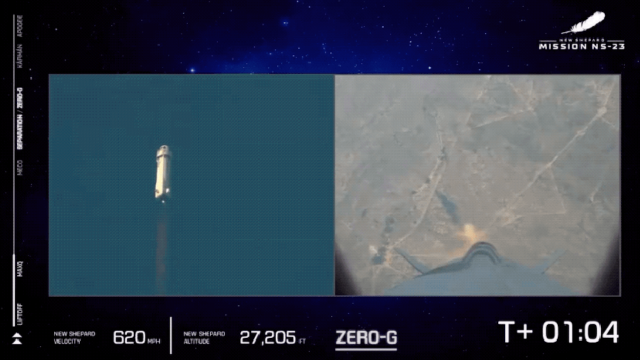An uncrewed flight of Blue Origin’s New Shepard suborbital rocket ended in failure shortly after liftoff on Monday morning from Launch Site One in West Texas. The capsule, packed with scientific and technological payloads, managed to survive an apparent booster malfunction, with the launch escape system successfully working as designed.
The booster anomaly happened just over one minute after the rocket launched today at 10:27 a.m. ET. Blue Origin’s live feed showed the rocket during MaxQ — the moment of maximum aerodynamic stress for a rocket — but the flight deteriorated quickly after that, with the booster becoming enveloped in flames. The camera then switched to a close-up view of the capsule, which ejected from the booster as a result of the anomaly (my guess is this was an automatic camera switch, as Blue Origin probably doesn’t want us watching its booster rockets exploding mid-flight).
Booster failure on today’s uncrewed flight. Escape system performed as designed. pic.twitter.com/xFDsUMONTh
— Blue Origin (@blueorigin) September 12, 2022
The booster failure happened as the rocket was travelling in excess of 1,127 km per hour (1,130 kilometers per hour) and while it was 29,000 feet (8,840 meters) above the ground. “We’re responding to an issue this morning at our Launch Site One location in West Texas,” Blue Origin tweeted. “The capsule escape system functioned as designed.” I reached out to Blue Origin for more information and to get confirmation that the booster was lost. A spokesperson said Blue Origin will provide updates through its Twitter as information becomes available.
Blue Origin’s NS-23 mission was originally supposed to launch on August 31, but poor weather resulted in a series of scrubs. New Shepard normally delivers tourists on suborbital flights to space, bringing them to just beyond the Kármán Line — the official demarcation point separating Earth’s atmosphere from outer space. The Jeff Bezos-led company has has flown 31 humans to space and performed six crewed flights since July 2021, the most recent happening on August 4, but that mission involved a different booster and capsule than the ones used today.
For the NS-23 mission, New Shepard was to carry 36 payloads, of which more than half belong to NASA, to heights in excess of 60 miles (100 kilometers). The successful parachute-assisted landing of the capsule suggests these items survived today’s mishap, but we’re still awaiting confirmation on that. That said, two payloads likely did not survive, as they were attached to the booster and designed to measure the space environment just outside the rocket. Of the 36 payloads involved in NS-23, 24 are from grade schools, universities, and STEM-focused organisations, including the American Institute of Aeronautics and Astronautics (AIAA) and the American Society for Gravitational and Space Research (ASGSR).
This capsule, named RSS H.G. Wells, is only used for uncrewed missions and is dedicated to sending cargo and research equipment on suborbital flights. The reusable booster, known as Tail 3, was used eight times prior to today’s launch.
The booster’s BE-3 main engine was supposed to fire until the 2:25 mark of the mission, with spacecraft separation happening around 35 seconds later. The capsule would then descend back to Earth with the help of a parachute, while the booster attempts a vertical landing similar to a SpaceX Falcon 9 booster. Tail 3 last flew on mission NS-17, which launched to suborbital space on August 26, 2021, carrying commercial payloads and an art piece known as Suborbital Triptych.
Today’s incident is the first significant blemish for New Shepard, an otherwise dependable rocket. An investigation into the anomaly is bound to ensue, and it’s likely that New Shepard will be grounded until more is known about the cause of the problem. The rocket’s launch escape system appeared to work flawlessly, but prospective space tourists might now think twice about riding aboard a New Shepard rocket. At least until Blue Origin has a better grip what happened today.
I guess it’s not a good month for American hydrogen fueled rockets, I hope Delta IV Heavy is fine.
— Scott Manley (@DJSnM) September 12, 2022
For propellant, New Shepard uses a combination of liquid hydrogen and liquid oxygen, the same mixture that’s currently causing complications with NASA’s Space Launch System (SLS) rocket. NASA is currently targeting September 23 or 27 for the inaugural launch, the first mission of the Artemis Moon program.
Related: Virgin Galactic’s SpaceShipTwo Flights Allowed to Resume After FAA Probe.
